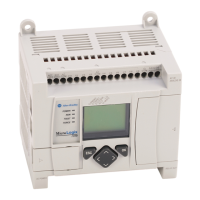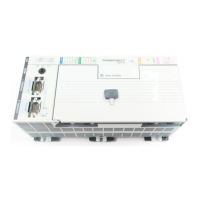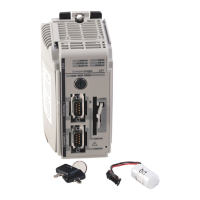Rockwell Automation Publication 1766-UM001O-EN-P - September 2021 287
Appendix G Connect to Networks via Ethernet Interface
Configure Using RSLogix
500/RSLogix Micro
Programming Software
See the online documentation provided with your programming software.
Configure Using BOOTP BOOTP (bootstrap protocol) is a low-level protocol that TCP/IP nodes use to
obtain start-up information. By default, the MicroLogix 1400 broadcasts
BOOTP requests at power up. The BOOTP Valid parameter remains clear until
a BOOTP reply has been received. BOOTP lets you dynamically assign IP
Addresses to processors on the Ethernet Link.
To use BOOTP, a BOOTP Server must exist on the local Ethernet subnet. The
server is a computer that has BOOTP Server software installed and reads a text
file containing network information for individual nodes on the network.
The host system’s BOOTP configuration file must be updated to service
requests from MicroLogix 1400 controllers. The following parameters must be
configured:
When BOOTP is enabled, the following events occur at power-up:
• The processor broadcasts a BOOTP-request message containing its
hardware address over the local network or subnet.
• The BOOTP server compares the hardware address with the addresses in
its look-up table.
MSG Reply Timeout
The amount of time (in ms) that the MicroLogix 1400 will wait for a reply to a command that it has initiated via a MSG
instruction. The MSG Reply Timeout has 250 ms resolution and a range from 250…65,500.
3,000 ms read/write
Inactivity Timeout
The amount of time (in minutes) that a MSG connection may remain inactive before it is terminated. The Inactivity
Timeout has a 1 minute resolution and a range from 1…65,500 minutes.
30 minutes. read/write
Contact The Contact string which is specified by the SNMP client. The maximum length is 63 characters. read only
Location The Location string which is specified by the SNMP client. The maximum length is 63 characters. read only
Network Link ID
The Link ID assigned to the MicroLogix 1400 by either an RSLinx OPC topic or by the routing table in a 1756-DHRIO or
1756-DH485 module. The range is 0…199.
0read/write
Starting Data File
Number
The first ASCII (A) file number in a contiguous block of 4-32 ASCII files (4 per User Provided Web Page). The range is
9…252 (or 0 for disable).
0read/write
Number of Pages The number of User Provided Web Pages, provided the Starting Data File Number is non-zero. The range is 1…8. 1 read/write
DNP3 over IP Enable
When DNP3 over IP is enabled (checked), the MicroLogix 1400 enables DNP3 over IP feature on Ethernet channel.
Power cycle is required for changes to take effect.
0 (disable) read/write
Modbus TCP Enable
When Modbus TCP is enabled (checked), the MicroLogix 1400 enables Modbus TCP feature on Ethernet channel. Power
cycle is required for changes to take effect.
0 (disable) read/write
Disable EtherNet/IP
Incoming
Connections
When EtherNet/IP Incoming Connections is disabled (checked), the MicroLogix 1400 does not allow the incoming
EtherNet/IP connection. However, MicroLogix 1400 can send the outgoing EtherNet/IP commands to other EtherNet/IP
devices. Power cycle is required for changes to take effect.
0 (disable) read/write
Disable Duplicate IP
Address Detection
When Duplicate IP Address Detection is disabled (checked), the MicroLogix 1400 does not send any packets to the
network to detect Duplicate IP on the same network.
0 (disable) read/write
Table 43 - Configuration Parameters (Continued)
Parameter Description Default Status
Table 44 - Configuration Parameters
Parameter Description
IP Address A unique IP Address for the MicroLogix 1400 controller.
Subnet Mask
Specifies the net and local subnet mask as per the standard on subnetting RFC 950, Internet
Standard Subnetting Procedure.
Gateway
Specifies the IP address of a gateway on the same subnet as the
MicroLogix 1400 that provides connections to another IP network.

